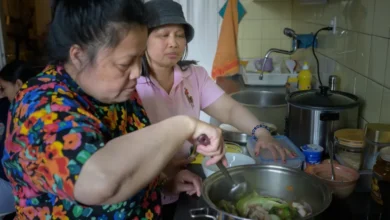The indigenous women saving India’s endangered giant yams
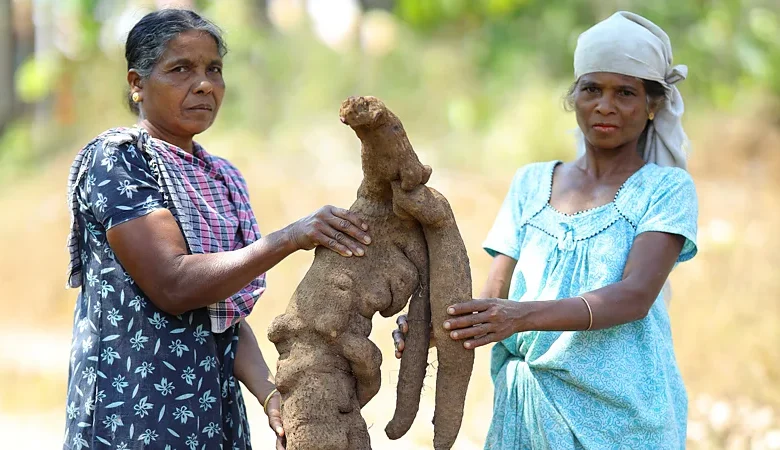
In a tribe in southern India, a group of women are working hard to revive the country’s ancient native tubers, and bring them back into everyday culture.
Lakshmi spends several hours each day digging out large lumpy and hairy yam tubers, starchy roots that grow below the soil.
Some weigh an unwieldy 5kg (11lb) and are 4.5ft-long (1.4m), almost as tall as she is. It’s painstaking work, says 58-year-old Lakshmi, who goes by one name.
First, she has to cut out the thick shoot above the ground. Then, she uses shovels to dig up the earth around the buried stem and a paddle-like flat chisel to gently pry out the tuber. She uses her hands to dig the tuber out of the ground to avoid damaging its delicate roots. When the tuber finally emerges from the ground, it is the colour of the earth, and holds the promise of spring, she says.
Lakshmi, who lives in the Wayanad district in the southern Indian state of Kerala, isn’t working alone. She’s part of an all-women group called Noorang, short for Nuru kilangu, a popular local variety of tuber.
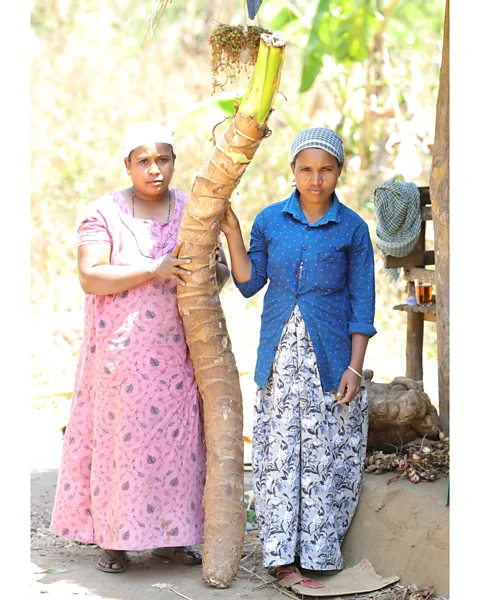
The Noorang members all belong to one of Kerala’s oldest indigenous tribes, the Vetta Kuruman, a nomadic community of hunters and food gatherers. They are on a mission to save the kilangu, which means “tuber” in Betta kurumba language, a mix of the South Indian languages of Kannada and Malayalam. These ancient tubers have grown on their land for centuries.
As a child, Lakshmi foraged for food in the forests, gathering edible roots, leaves, honey and fruit.” [The kilangu] at the time, was a substantial meal in itself and there were so many varieties that we never got bored,” says Lakshmi. “We would have different kinds of yams and sweet potatoes for at least one meal a day. My family would eat it boiled, steamed and roasted. It’s a vital part of my childhood memories.”
The goal is to save as many varieties of rare seeds that we can find – Sarasu
But tubers are no longer a dietary staple among tribal communities in Kerala due to their rapidly changing lifestyle and eating habits. Younger people who have ready access to a wide variety of other foods, especially rice and wheat, no longer consider the tubers that once nourished their ancestors as anything special, says TV Sai Krishnan, the coordinator of the Thirunelly Tribal Comprehensive Development Project in Wayanad, which focuses on the wellbeing of tribal people in the state.
Extreme weather has also destroyed tuber harvests in recent years. Although the tubers are fairly resilient to heat, Wayanad’s frequent flooding and deadly landslides, an annual occurrence since 2019, have caused many waterlogged crops to rot.
Between 2005 and 2015, there was a steep decline in lands dedicated to tuber production in Kerala, with many of these being diverted to the more lucrative rubber cultivation instead, according to a report by the Central Tuber Crop Research Institute of Kerala.
Conserving these tubers, most of which are roughly 2-3ft long (60-90cm), isn’t just an endeavour to preserve old ways and habits, it’s also about boosting nutrition, says V Shakeela, director of the Community Agrobiodiversity Centre of MS Swaminathan Research Foundation, based in Wayanad.
“It’s the solution to many mounting problems that these tribal communities are facing in the present, especially malnutrition and providing food security in the face of [worsening] climate change,” says Shakeela. National data shows that the health of indigenous people is significantly poorer than other groups.
“Primarily, the women growing these tubers are doing so to nourish their own families, and to ensure that these ancient rare varieties don’t fade away,” Shakeela says.
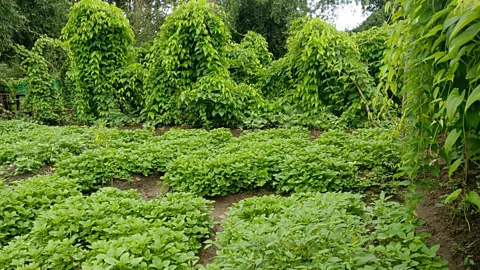
Women in her community have always taken the lead in gathering tubers, Lakshmi says. They didn’t have to venture too far into the forests to find them, and they were easy to stack and store, providing plenty of food for a growing family.
“We believe in the medicinal value of these indigenous tubers,” says Shantha, another member of the Noorang group. “Most mothers here will swear by its ability to cure digestive and stomach problems, especially if you cook it with turmeric.”
A disappearing lifestyle
The Vetta Kuruman community once lived in small scattered settlements deep in the forests of Wayanad, which were vulnerable to floods and landslides.
In 2003, the community of roughly 700 people was resettled by the Keralan government and made their new homes on the outskirts of the forests in which they once lived.
In 2016, the government gave each family half an acre of land to use how they saw fit – with the majority using it for agriculture and raising cattle. That change marked a distinct shift in dietary habits for the tribal communities, says Sai Krishnan.
The Thirunelly Tribal Comprehensive Development Project founded the Noorang group during the Covid-19 pandemic, in May 2022, with the aim of improving food security for tribal communities and to deal with their shift away from foraging tubers in the forests to cultivating rice, banana, vegetables and other crops on their lands.
CARBON COUNT
The emissions from travel it took to report this story were 0kg CO2. The digital emissions from this story are an estimated 1.2g to 3.6g CO2 per page view.
The project is part of the Kudumbashree Mission in Kerala (kudumbashree means “the prosperity of family” in the local Malayalam language), a government farming initiative to eradicate poverty, provide agricultural training and empower women in vulnerable tribal communities.
“During Covid-19, we conducted an educational programme for the children of tribal members. We mapped the food they ate, and that’s when we learned that many of them weren’t really aware of the rich tuber varieties that once used to be the mainstay of their communities,” says Saikrishnan.
The survey showed that dietary habits were changing, he says. Children showed a preference for rice, which the state government provides free to low-income families through a public distribution system.
“Tubers were always a quick, rich source of protein for us in the past,” says Lakshmi. “If our children were to move away from our traditional source of food, that would be a great loss indeed. Losing the nutrition that we have relied on for generations would be like losing part of our identity.”
It’s the solution to many mounting problems that these tribal communities are facing in the present – V Shakeela
Since their formation in 2022, the 10 members of the Noorang group have planted and brought back to the community 180 varieties of wild tubers, including 15 varieties of wild yam (noorang), three varieties of elephant yam, eight types of Colocasia (also known as elephant ears, a potato-like tuber), 16 species of turmeric, four kinds of tapioca, seven varieties of sweet potato, two of ginger, three of arrow root and one Chinese potato.
“The goal is to save as many varieties of rare seeds that we can find and to cultivate and nurture more tubers,” says Sarasu, a member of Noorang.
When they first began clearing the land for planting, they faced a Herculean task, says Sarasu, because they couldn’t afford to hire labour and many the thorny scrubs and plants that dotted the land, including invasive species like Lantana camera. This scrambling shrub can grow 2-4m (6.6-13.1ft) tall and forms dense thickets, full of sharp, thorny prickles.
“Our hands would bleed at the end of a day clearing… [they were] all raw and sore,” says Sarasu. “We do everything ourselves, without the help of tractors that big farmers use. And we cannot afford to pay for help yet.” Inadequate funds have also hampered their own efforts, she says.
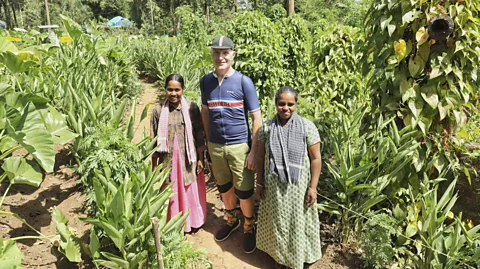
The Noorang group operates on a tight budget. The land is provided by Noorang member Shantha’s family and is leased to the other members for five years. In return, the other women pay her a sum of 5,000 rupees per year, which works out to roughly 3.5% of the collective’s 150,000-rupee yearly revenue (£1,400/$1,800).
In addition to foraging for wild tuber seeds in the forest, members are also using seeds provided by local farmers for free, who have been eager to help them.
“The tubers must be planted during the peak summer months in April and May before the monsoons set in so that the crop can benefit the most from the rainy weather. The harvest season is from December to March,” says Sai Krishnan.
The tubers the women have collected and sown have grown rapidly. The women take turns weeding the land on alternate days, while juggling their role as wives and mothers, caring for poultry and doing odd jobs to earn extra income.
“We need to keep up paying work as well, so we have enough income for our families,” says Sarasu. “In spite of the hardships, growing tubers is something we do for ourselves, regardless of how little we receive from it. To me, it’s like embracing a part of our heritage.”
Knowing that the work we do is important and useful, that’s kept us going – Shantha
The women sell their produce in local markets themselves, and at fairs across Kerala, with each earning an average of 9,000-15,000 rupees (£80/$107) a year. “Since we cannot pay for [agricultural] labour, there are limitations to how much we can produce at the moment,” says Lakshmi.
The women face other challenges as well. Monkeys and wild boars tend to snack on their produce. Wild elephants cause great damage to crops as well.
While tubers are hardy crops, resistant to heat and don’t require too much water, the women say floods and landslides pose a threat to these crops. While flooding is a problem during the monsoons, severe drought in the summer months can be just as damaging. The lack of water can impact the development of the tuber, causing it to shrivel up and shrink, affecting the quality of the crop.
At the beginning of every year, during the harvest festival called Thiruvathira, the women display their produce at the Thirunelly Seed Festival, alongside many other farmers who showcase their own climate-resistant seeds and farm produce. “Interacting with a wider community of farmers has always given us new insights and inspiration,” says Shantha. “It makes us feel that we aren’t working alone, in isolation. Knowing that the work we do is important and useful, that’s kept us going.”
Locally, their labour has not gone unrecognised. During the harvest festival, local authorities come to see their tubers and survey their agricultural practices, says Sarasu. Sometimes, the women have the opportunity to meet other farmers or interact with foreign tourists who sample their tubers. “This interaction and exchange of ideas has been so empowering,” says Sarasu. But there’s another reason why the women persevere.
“We think of our project as something special that we’re doing for the next generation,” says Shantha. “And that’s what makes it so meaningful.”


